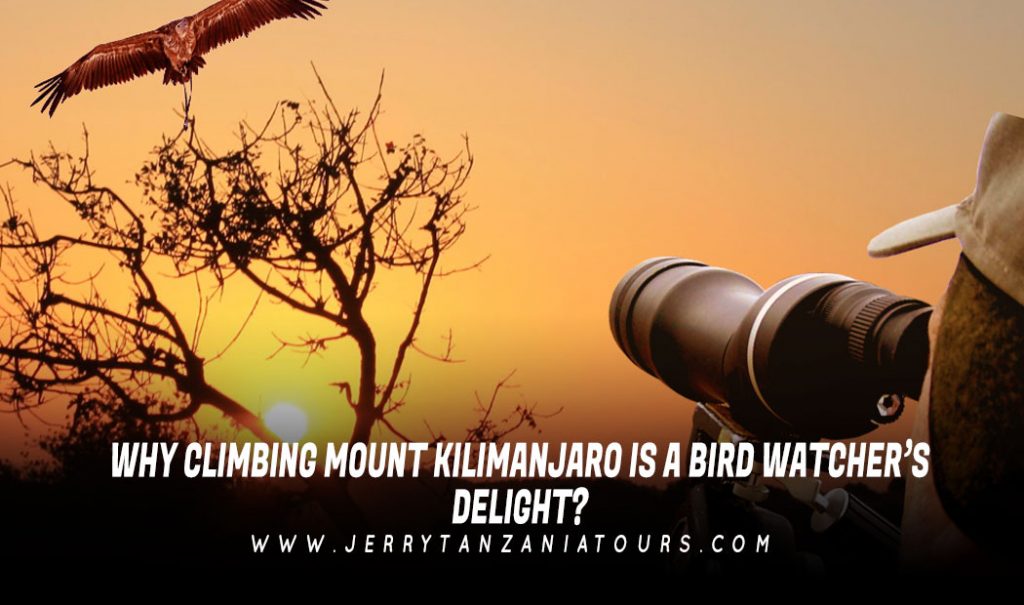
Among the many surprises, you will witness while Climbing Mount Kilimanjaro coming across the numerous bird varieties and watching them is a true delight for the bird watchers on Mount Kilimanjaro. Let’s look into the amazing variety of birds that you will come across on your Kilimanjaro Climb.
Hartlaub’s Turaco
The most amazing fact you will come across as part of Climbing Mount Kilimanjaro for Beginners is witnessing the Hartlaub’s Turaco which was named to commemorate German physician and ornithologist Gustav Hartlaub. With red surrounding its eye, a black crest on its head, and a white spot anterior to the eye, this gorgeous bird makes for a dramatic presentation. Often be identified with the dash of crimson on its underwings Hartlaub’s Turaco flashes brightly amongst a sea of forest green.
Schalow’s Turaco
Named after a German banker and amateur ornithologist, Hermann Schalow, Schalow’s Turaco is light for its species, weighing just over half a pound (270g), with a length of 15-17 inches. With Jade green plumage covering most of its body and flowing into the long, white-tipped crests upon its head, this magnificent bird has shimmering blue feathers fading into the dark.
Violet Turaco
The often inconspicuous and unmistakable Violet Turaco that you find on your Mount Kilimanjaro Climbing is quite timid. This large turaco is approximately 48 cm long (19 in), and is also known as the violaceous plantain eater. This bird with a long violet tail and a thick, 4 cm (1.6 in), the reddish-orange bill has a yellow forehead, white ear coverts, chestnut crown, and scarlet flight feathers. This contrasts with the rest of its violet plumage.
Narina Trogon
With our expert Climb Kilimanjaro Guide, you will learn a lot about the Narina Trogon whose name honors the mistress of French ornithologist Francois Le Vaillant. Deriving the word Narnia from a Khoikhoi word for “flower” he had a great difficulty pronouncing her given name. The main cause leading to the depletion of local numbers of this medium-sized (32-34cm long), amaranth, and green species is deforestation.
Silvery-Cheeked Hornbill
The Best Time to Climb Kilimanjaro to observe the best of the birds such as the Silvery-Cheeked Hornbill is during the green season from December to March and the Peak season from June to September. This bird measures 75-80 centimeters (30-31 inches) in length and has a large, cream-colored casque on the beak.
Trumpeter Hornbill
To choose the Best Route to Climb Kilimanjaro we suggest you speak to our travel experts who will also suggest you timings to sight the occasional Trumpeter Hornbill in the forest canopy. The medium-sized Trumpeter hornbill has a length between 58-65 centimeters (23-26 inches). This bird is quite similar to its Silvery-Cheeked relative except with some differences.
Emerald Cuckoo
Choose some of our fantastic Climb Mount Kilimanjaro Packages and witness the great African Emerald Cuckoo. This bird is an old world cuckoo, and like most other old-world cuckoos, a brood parasite. The female of this species lays 19-25 eggs on an average per breeding season. These birds lay eggs in nests of other species. The cuckoo’s chicks grow faster.
Klaas’ Cuckoo
Just like the Narina Trogon the Klaas’s Cuckoo was named by the French explorer and ornithologist Francois Le Vaillant. The only colonial biologist to name bird species after local people was Le Vaillant. Ranging from about 16-18 cm in length these Cuckoos are sexually dimorphic. The males exhibit green bodies with few markings and white underbellies. Whereas the females show bronze-brown bodies with greenish wing coverts.
White Brown Coucal
The Lark-Heeled Cuckoo or the White Brown Coucal inhabits areas thick with cover afforded by dense shrubs and undergrowth. This marvelous bird exhibits some unique reproductive traits with the male provides most of the parental care. This coucal is medium-sized and grows to a length of 36-42 cm (14-17 in) in length.
Cinnamon-Chested Bee-Eater
While Climbing Mount Kilimanjaro you will come across the Cinnamon-chested bee-eaters are which are about 22 cm long (8.7 inches) and weigh 17-38 g (.6-1.34oz). There is great similarity in both the sexes have a similar appearance, who have bright green heads, backs, and tails. With yellow throat and a black outline, these birds have a cinnamon brown chest. With an orange base and white tip, the inner tail is blackish.
African Pitta
You will also come across the African Pitta while Climbing Mount Kilimanjaro which is often nicknamed the “holy grail” of African birds. The mysterious species is hard to observe despite its brightly colored plumage. This bird also showcases loud and explosive calls.
Join Jerry Tanzania Tours and Watch the serenity of Kilimanjaro
If you choose to climb Kilimanjaro we suggest you climb Mount Kilimanjaro with us. We at Jerry Tanzania Tours offer you the best climbing Mount Kilimanjaro advice even for Climbing Kilimanjaro Solo hikers. The dedicated Kilimanjaro Porters and crew will assist you in hiking the mountain with ease. We will also guide you in saving on your Kilimanjaro Climb Cost.
So contact us to prepare the most bespoke Kilimanjaro Climbs with us today!
